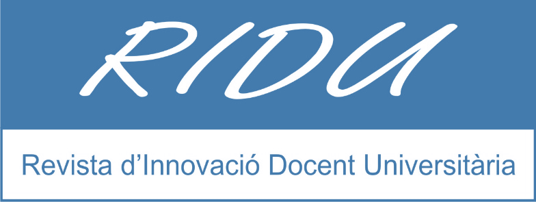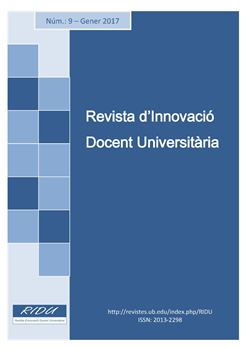L'aula invertida i l'aprenentatge en equip: dues metodologies per estimular l'alumnat repetidor
DOI:
https://doi.org/10.1344/RIDU2017.9.1Paraules clau:
Innovació docent, Aula invertida, Aprenentatge en equipResum
Aquest article proposa l'ús de l'aula invertida i l'aprenentatge en equip per millorar les actituds d'aprenentatge de l'alumnat en els Grups d'Intensificació d'Estudis (GIE) a la Universitat de Barcelona. El GIE està dissenyat per a aquell alumnat que repeteix una assignatura en algun dels graus impartits a la Facultat d'Economia i Empresa de la Universitat de Barcelona. Hem implementat dues metodologies en tres GIE impartits per la secció de Teoria Econòmica del Departament d'Economia de la Universitat de Barcelona. Els resultats obtinguts en els anys acadèmics 2013-2014 i 2014-15 revelen millores significatives en el rendiment dels estudiants que van seguir aquestes metodologies.
Referències
Baepler, P. (2014) It's not about seat time: Blending, flipping, and efficiency in active learning classrooms. Computers and Education, 78, pp. 227-236.
Bergmann, J., Sams, A. (2012) Flip your classroom: Reach every student in every class every day. Washington, D.C.: International Society for Technology in Education.
Berrett, D. (2012) How ‘flipping’ the classroom can improve the traditional lecture. The Chronicle of Higher Education. Disponible en: http://chronicle.com/article/How-Flipping-the-Classroom/130857/.
Chung, K. (2014) Professors ‘flip’ classrooms, enhance learning. Daily Tar Heel. Disponible en: http://www.dailytarheel.com/article/2014/01/flipped-classrooms-0108.
Crouch, C., Mazur, E. (2001) Peer Instruction: Ten Years of Experience and Results. American Journal of Physics, 69, pp. 970-977.
Deslauriers, L., Schelew, E., Wieman, C. (2011) Improved Learning in a Large-Enrollment Physics Class. Science, 332, pp. 862-864.
Hong, T., Pham, T. (2013) Using group projects as a strategy to increase cooperation among low - and high-achieving students. Higher Education Research and Development, 32, pp. 993-1006.
Jackson, M.W., Prosser, M.T. (1989) Less lecturing, more learning. Studies in Higher Education, 14, pp. 55-68.
King, A. (1993). From sage on the stage to guide on the side. College teaching, 41, pp. 30-35.
Knight, J.K., Wood, W.B. (2005) Teaching More by Lecturing Less. Cell Biology Education, 4, pp. 298-310.
Kruger, J., Dunning, D. (1999) Unskilled and unaware of it: How difficulties in recognizing one’s own incompetence lead to inflated self-assessments. Journal of Personality and Social Psychology, 77, pp. 1121-1134.
Lage, M.J., Platt, G.T., Treglia, M. (2000) Inverting the classroom: A gateway to creating an inclusive learning environment. The Journal of Economic Education, 31, pp. 30-43.
Mazur, E. (1997) Peer Instruction: A User's Manual Series in Educational Innovation. Prentice Hall, Upper Saddle River, NJ.
McLaughlin, J.C. (2013) Pharmacy student engagement, performance, and perception in a flipped satellite classroom. American Journal of Pharmaceutical Education, 77, pp. 1-8.
Michaelsen, L.K., Knight, A.B., Fink, L.D. (2004) Team-Based Learning: A Transformative Use of Small Groups in College Teaching. Sterling, Va. Stylus.
Millis, B. J., Cottell, P.G. (1998) Cooperative Learning for Higher Education Faculty. Oryx Press, Phoenix, Ariz.
Missildine, K., Fountain, R., Summers, L., Gosselin, K. (2013) Flipping the classroom to improve student performance and satisfaction. Journal of Nursing Education, 52, pp. 597- 599.
Nordberg, D. (2008) Group projects: More learning? Less fair? A conundrum in assessing postgraduate business education. Assessment and Evaluation in Higher Education, 33, pp. 481-492.
Opdecam, E., Everaert, P., Van Keer, H. (2014) Preferences for Team Learning and Lecture-Based Learning Among First-Year Undergraduate Accounting Students. Research in Higher Education, 55, pp. 400-432.
Park, E.L., Choi, B.K. (2014) Transformation of classroom spaces: traditional versus active learning classroom in colleges. Higher Education, 68, pp. 749-771.
Pennebaker, J.W., Gosling, S.D., Ferrell, J.D. (2013) Daily Online Testing in Large Classes: Boosting College Performance while Reducing Achievement Gaps. PloS ONE, 8(11), e79774.
Prieto, A., Díaz, D., Montserrat, J., Reyes, E. (2014) Experiencias de aplicación de estrategias de gamificación a entornos de aprendizaje universitario. ReVisión, 7, pp. 76-92.
Roediger, H.L. III, Putnam, A.L., Smith, M.A. (2011) Ten benefits of testing and their applications to educational practice. Edited by: Mestre, J.P., Ross, B.H. Psychology of Learning and Motivation: Cognition in Education,Book Series: Psychology of Learning and Motivation, Volumen 55, pp. 1-36.
Shah, S.Z.A. (2013) The use of group activities in developing personal transferable skills. Innovations in Education and Teaching International, 50, pp. 297-307.
Strayer, J. (2012) How learning in an inverted classroom influences cooperation, innovation and task orientation. Learning Environments, 15, pp. 171-193.
Wilson, S.G. (2013) The flipped classroom: A method to address the challenges of an undergraduate statistics course. Teaching of Psychology, 40, pp. 193-199.
Yamarik, S. (2007) Does Cooperative Learning Improve Student Learning Outcomes? Journal of Economic Education, 38, pp. 259-277.
Descàrregues
Publicades
Número
Secció
Llicència
L'autor/a que publica en aquesta revista accepta les condicions següents:
- L'autor/a conserva els drets d’autoria i atorga a la revista el dret de primera publicació de l’obra.
- Els textos es difondran amb la llicència de reconeixement 4.0 Espanya de Creative Commons, la qual permet compartir, distribuir, reproduir i la comunicació pública, sempre que se’n reconegui l’autoria i la revista.







